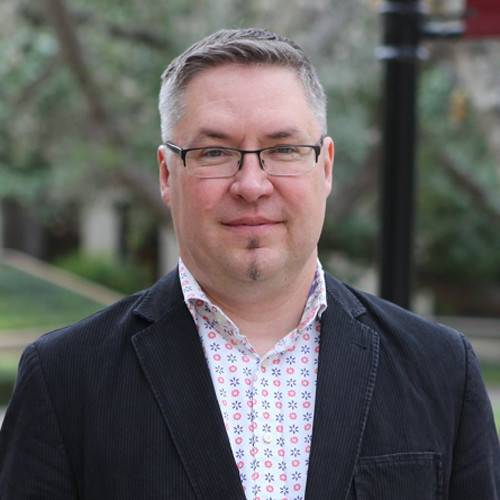Stefanie Scott | February 8, 2022

As Texas continues to see rapid growth, Texas State University’s Dr. Robert Mace is focused on making sure the state has clean, abundant water supplies to support its future.
With more than 30 years of experience in water policy, hydrology and hydrogeology, Mace is executive director and Chief Water Policy Officer at the Meadows Center for Water and the Environment and is a Professor of Practice in the Department of Geography at Texas State.
Before joining Texas State in 2017, Mace worked at the Texas Water Development Board for 18 years, working on understanding groundwater and surface water resources in Texas; advancing water conservation and innovative water technologies such as desalination, aquifer storage and recovery, reuse, and rainwater harvesting and protecting Texans from floods.
Mace also worked at the Bureau of Economic Geology at the University of Texas at Austin as a hydrologist and research scientist.
A native of Illinois, Mace has a Bachelor of Science in Geophysics and a Master of Science in Hydrology from the New Mexico Institute of Mining and Technology and a Ph.D. in Hydrogeology from the University of Texas at Austin.
Q: How did you become interested in water and hydrogeology?
A: When I was a kid, I had many interests, but I was really interested in rocks and good in math. My mom said: “You should become a geophysicist!” So, I went to college to become a geophysicist. I didn’t have much money, so I was always applying for scholarships. I applied for a general scholarship which required me to write about how my degree choice was going to make the world a better place. Since geophysicists generally worked in the oil industry, I wrote about helping the world find more oil. Nothing against the oil industry, but my words rang hollow.
Meanwhile, I was working in the cafeteria doing dishes complaining to my upperclassman co-worker about not having a job in a lab, a big reason I went to New Mexico Tech. “Have you applied for any?” he asked. I hadn’t. I was in a goth-electro band at the time (named Memento Mori) and had hair bigger than a Dallas socialite. “Who’s gonna hire me?” I asked in response. “Find out who Olivia works for,” he replied.
Olivia was a graduate student who also had crazy, explosive hair. I found out that she was in the Hydrology Department and was a student of Dr. Dan Stephens. I checked the job postings, and—lo and behold—he was looking for a student worker in his lab. I applied, got interviewed (hair and all), and got the job. Once imbedded, I learned that I liked the people and the subject and that the math in geophysics applied to hydrogeology. I worked for Dan Stephens on campus and then for his budding consulting firm as an undergraduate and then stayed at New Mexico Tech to earn a master’s degree in hydrology.
Q: Can you tell us about the mission of the Meadows Center for Water and the Environment?
A: The mission of the Meadows Center is to inspire research and leadership that ensures clean, abundant water for environment and all of humanity. The Meadows Center searches for what I call the “third way” -- a path where the needs of people and the environment are both met.
Q: What is the outlook for water supplies in Texas?
A: Texas is fortunate to have had water planning since the 1960s—critical in a state with rapid economic growth and subject to the quiet wrath of drought. The current water plan projects that, with the implementation of strategies to acquire more water, most water users will have enough water for the future during a repeat of the drought of record. One major exception to that is irrigated agriculture on the High Plains where we are mining groundwater from the Ogallala Aquifer at more than six times the aquifer is being replenished. While we have a great water-planning process, we don’t plan for climate change. This is troubling because our warming climate is expected to reduce our water availability through less runoff and recharge and more intense droughts.
Q: What are the most bizarre facts people may not know about Texas groundwater?
A: Some key facts include:
- 40 percent of all the water used in Texas comes from the Ogallala Aquifer.
- In an average year, the Ogallala Aquifer gets more recharge than the Edwards Aquifer.
- Texas almost piped in water from the Mississippi in the 1960s to manage its aquifers sustainably (notably the Ogallala Aquifer).
- You can “fish” for catfish in 2,000-foot deep wells in the Edwards Aquifer in southern Bexar County.
Q: What are your top three takeaways on the future of water in Texas and around the world?
A: Key takeaways include:
- Climate change will have profound effects on water supplies.
- We will need every tool in the toolbox to meet our future water needs.
- We can do this!
Share this article
For more information, contact University Communications:Jayme Blaschke, 512-245-2555 Sandy Pantlik, 512-245-2922 |
